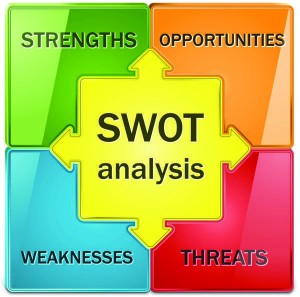Free Blank SWOT Analysis Template in Word
Most people with a background in business or marketing will have heard of the term, SWOT analysis. But, what exactly is a SWOT analysis and how do we go about the task of creating one using a SWOT analysis template?
To answer the first part of this question, A SWOT analysis is a two-phase business evaluation technique. It is commonly used by managers to identify their company’s:
- Strengths;
- Weaknesses;
- Opportunities; and
- Threats.
Sometimes a SWOT analysis is referred to, as a TOWS analysis. This is due to the popular belief that threats and opportunities should be analysed first. That is, prior to the evaluation of the business’s strengths and weaknesses. The image, below, provides a colour-coded visual illustration of the popular technique.
Before we explain how to create a SWOT analysis, and direct you to download our free SWOT analysis template in Word, there are two important issues you will need to understand.
- Strengths and weaknesses are found within our business’s internal environment; and
- Opportunities and threats are identified from within the external environment.
We’ll now explain the SWOT analysis process. And we’ll also supply examples to help you to better understand the difference between these types of environmental forces.
Note: Please do not download our SWOT Analysis Template just yet. A prior understanding of these forces will be crucial in the success of your analysis.
How to conduct a SWOT analysis
Phase One:
First, we’ll need to analyse the external environment in which our business operates. In other words, we undertake a comprehensive PEST analysis. [Note: For your convenience, the link opens in a new window].
Our PEST analysis provides us with a systematic approach to predicting the impact of political, economic, social and technological forces on our business.
By way of example, some businesses might regard a softening economy as a threat, while other businesses might see it as an opportunity. A pet food manufacturer, for instance, might have a very successful range of upmarket dog food. Concerned by the possible affects of a softening economy on their sales, management might see opportunity to introduce another, more affordable range, under a new brand. The idea here would be to offer two brands – running side-by-side – with a separate marketing mix for each.
Phase Two:
Our next task is to carefully evaluate our internal environment. During this process, we consider factors such as:
- Our financial situation (the cash we have available)
- Our human resources (staff), including their skills and capabilities
- The location of our business (is it convenient for our customers?)
- The reputation of our business, goods or services (can we improve?)
- Our research and development (R&D) capabilities (this is often restricted by limited financial resources)
As an example, a small firm’s limited financial resources could be regarded as a weakness. While the same business’s highly skilled, knowledgeable and friendly staff could be regarded as a strength. To another business, limited financial resources (limited cash) might be regarded as a significant threat to its very existence.
Conducting a SWOT analysis can be a very beneficial strategic marketing process. In fact, it was the findings we uncovered in a recent marketing SWOT analysis, which provided us with the idea to launch our now very popular WordPress Maintenance Service. As another example, one of our client’s has a successful commercial finance business. Their comprehensive SWOT analysis revealed a number of lucrative niche market segments. As a direct result of their SWOT, they are now actively helping small business owners source and secure, low interest rate truck finance.
Competitive SWOT analysis
In addition to compiling a SWOT analysis for their own business, prudent marketing managers will also perform the same analysis applied to their competitive environment. This enables the management to compare their own performance against that of their competitors.
However, for this to work, those involved in the process must be objective. In other words, they need to be completely honest with themselves, as far as their observations are concerned.
In essence, all businesses have strengths and weaknesses. Recognising that our competitors are doing a better job than us, in one or more areas, is the first step in the right direction. It is only after we can recognise this, that we can take the appropriate action to correct this. Of course, as with any thing in life, if you do isolate an attractive new marketing opportunity, it’s up to you to bring your marketing opportunity to life.
Where’s my SWOT analysis template?
If you’ve found this article helpful, you’re welcome to download our free blank SWOT analysis template. It’s been created in MS Word and is fully editable. You can help us by sharing this article on social media.


